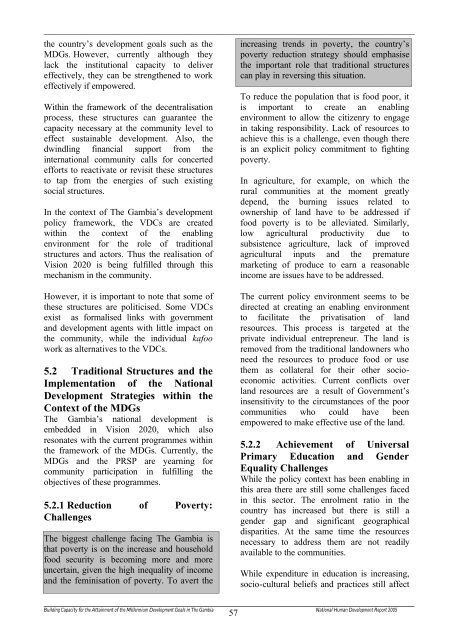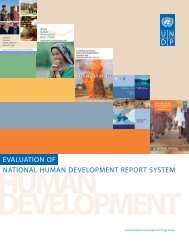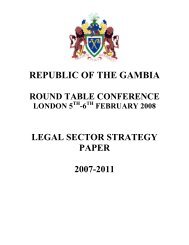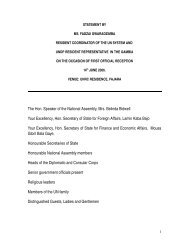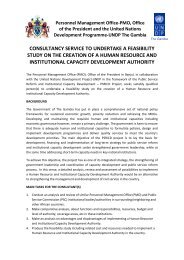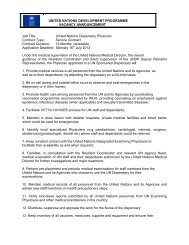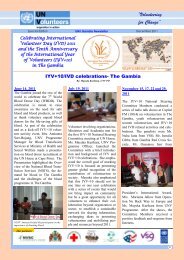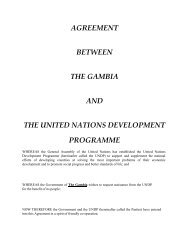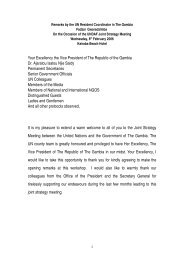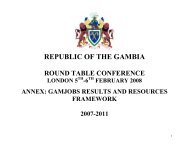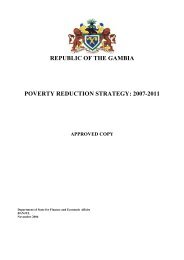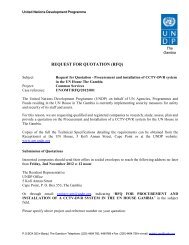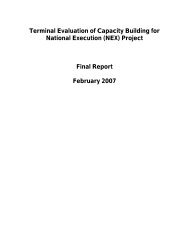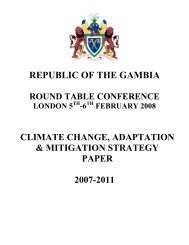Introduction - UNDP The Gambia
Introduction - UNDP The Gambia
Introduction - UNDP The Gambia
You also want an ePaper? Increase the reach of your titles
YUMPU automatically turns print PDFs into web optimized ePapers that Google loves.
________________________________________________________________________________________________________________________<br />
the country’s development goals such as the<br />
MDGs. However, currently although they<br />
lack the institutional capacity to deliver<br />
effectively, they can be strengthened to work<br />
effectively if empowered.<br />
Within the framework of the decentralisation<br />
process, these structures can guarantee the<br />
capacity necessary at the community level to<br />
effect sustainable development. Also, the<br />
dwindling financial support from the<br />
international community calls for concerted<br />
efforts to reactivate or revisit these structures<br />
to tap from the energies of such existing<br />
social structures.<br />
In the context of <strong>The</strong> <strong>Gambia</strong>’s development<br />
policy framework, the VDCs are created<br />
within the context of the enabling<br />
environment for the role of traditional<br />
structures and actors. Thus the realisation of<br />
Vision 2020 is being fulfilled through this<br />
mechanism in the community.<br />
increasing trends in poverty, the country’s<br />
poverty reduction strategy should emphasise<br />
the important role that traditional structures<br />
can play in reversing this situation.<br />
To reduce the population that is food poor, it<br />
is important to create an enabling<br />
environment to allow the citizenry to engage<br />
in taking responsibility. Lack of resources to<br />
achieve this is a challenge, even though there<br />
is an explicit policy commitment to fighting<br />
poverty.<br />
In agriculture, for example, on which the<br />
rural communities at the moment greatly<br />
depend, the burning issues related to<br />
ownership of land have to be addressed if<br />
food poverty is to be alleviated. Similarly,<br />
low agricultural productivity due to<br />
subsistence agriculture, lack of improved<br />
agricultural inputs and the premature<br />
marketing of produce to earn a reasonable<br />
income are issues have to be addressed.<br />
However, it is important to note that some of<br />
these structures are politicised. Some VDCs<br />
exist as formalised links with government<br />
and development agents with little impact on<br />
the community, while the individual kafoo<br />
work as alternatives to the VDCs.<br />
5.2 Traditional Structures and the<br />
Implementation of the National<br />
Development Strategies within the<br />
Context of the MDGs<br />
<strong>The</strong> <strong>Gambia</strong>’s national development is<br />
embedded in Vision 2020, which also<br />
resonates with the current programmes within<br />
the framework of the MDGs. Currently, the<br />
MDGs and the PRSP are yearning for<br />
community participation in fulfilling the<br />
objectives of these programmes.<br />
5.2.1 Reduction of Poverty:<br />
Challenges<br />
<strong>The</strong> biggest challenge facing <strong>The</strong> <strong>Gambia</strong> is<br />
that poverty is on the increase and household<br />
food security is becoming more and more<br />
uncertain, given the high inequality of income<br />
and the feminisation of poverty. To avert the<br />
<strong>The</strong> current policy environment seems to be<br />
directed at creating an enabling environment<br />
to facilitate the privatisation of land<br />
resources. This process is targeted at the<br />
private individual entrepreneur. <strong>The</strong> land is<br />
removed from the traditional landowners who<br />
need the resources to produce food or use<br />
them as collateral for their other socioeconomic<br />
activities. Current conflicts over<br />
land resources are a result of Government’s<br />
insensitivity to the circumstances of the poor<br />
communities who could have been<br />
empowered to make effective use of the land.<br />
5.2.2 Achievement of Universal<br />
Primary Education and Gender<br />
Equality Challenges<br />
While the policy context has been enabling in<br />
this area there are still some challenges faced<br />
in this sector. <strong>The</strong> enrolment ratio in the<br />
country has increased but there is still a<br />
gender gap and significant geographical<br />
disparities. At the same time the resources<br />
necessary to address them are not readily<br />
available to the communities.<br />
While expenditure in education is increasing,<br />
socio-cultural beliefs and practices still affect<br />
________________________________________________________________________________________________<br />
Building Capacity for the Attainment of the Millennium Development Goals in <strong>The</strong> <strong>Gambia</strong> National Human Development Report 2005<br />
57


